Top Sales Follow-Up Statistics for 2024 [+ Templates]
Most salespeople know that following up can make a significant difference in their outreach strategy. Follow-ups can turn a cold email that goes unanswered into a mutually beneficial conversation that leads to a close.
Yet nearly half of sales reps don’t follow up at all.
The numbers paint a bleak picture:
- Only 2% of sales happen during the first point of contact (source)
- 60% of customers reject offers four times before making a purchase decision (source)
- 70% of sales reps will only send one email to prospects, giving up a 25% chance of getting a response (source)
- Half of buyers go for the vendor that replies first (source)
In 2024, sales teams must have a strong and consistent follow-up strategy implemented into their sales process.
Our data tells us that the average sales rep sends two follow-up emails; is that enough?
We looked at 10 million email threads from sales professionals to find some of the most notable sales follow-up statistics to help guide your strategy. Let’s take a look.
Here’s what we’ll cover:
- How to Follow Up on a Sales Lead
- Number of Times to Follow Up & Cadence
- The Best Time of Day to Follow Up
- Top Sales Follow-Up Statistic: The 24-Hour Rule
- The Most Effective Sales Follow-Up Templates
How to Follow Up on a Sales Lead
Before we dive into some top sales follow-up statistics, let’s first look at what a good follow-up email looks like and our tips for engaging with recipients and generating a reply.
1. Provide Value
Effective follow-up emails don’t ask your prospect for something, they show your prospect what you can do for them.
With every follow-up, you should continue to demonstrate the value that you can provide.
One of the best ways you can do this is to share content that’s relevant to the recipient’s pain points and current challenges.
Here’s an example:
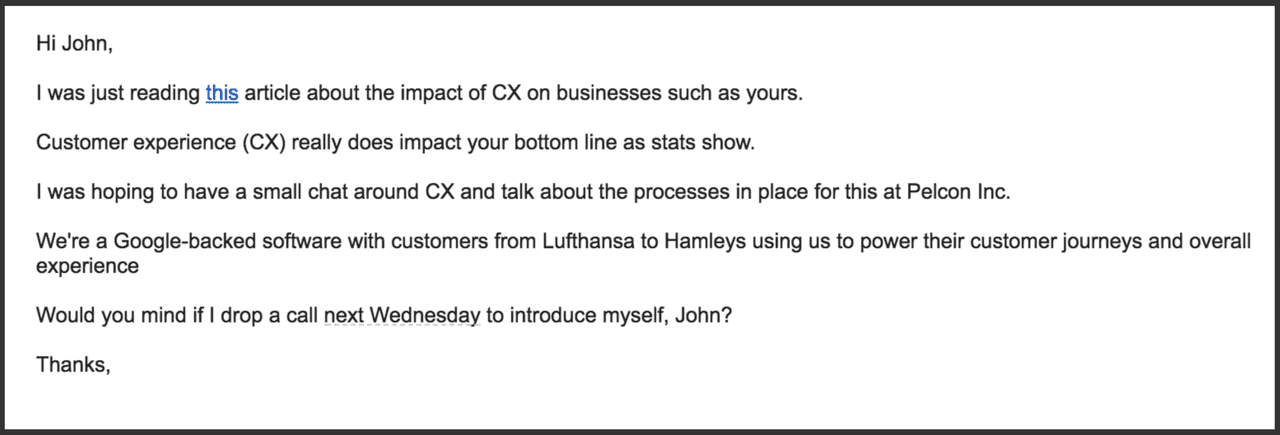
2. Be Concise
It’s easy to get carried away with your follow-ups when the focus is on sparking conversation, demonstrating value, and creating connections. But you also need to make sure you’re not smothering the recipient with long text.
Be concise and get to the point.
When sending follow-up emails, always make sure your ask is clear and that the recipient knows why you’re reaching out.
You can do this by using bold words, bullet points, or numbers to separate your ideas and draw the recipient’s attention to important information.
If you make it easier for your prospect to find the main points of the message before clicking away, they’re likely to stay on your message longer (especially if the points resonate with them).
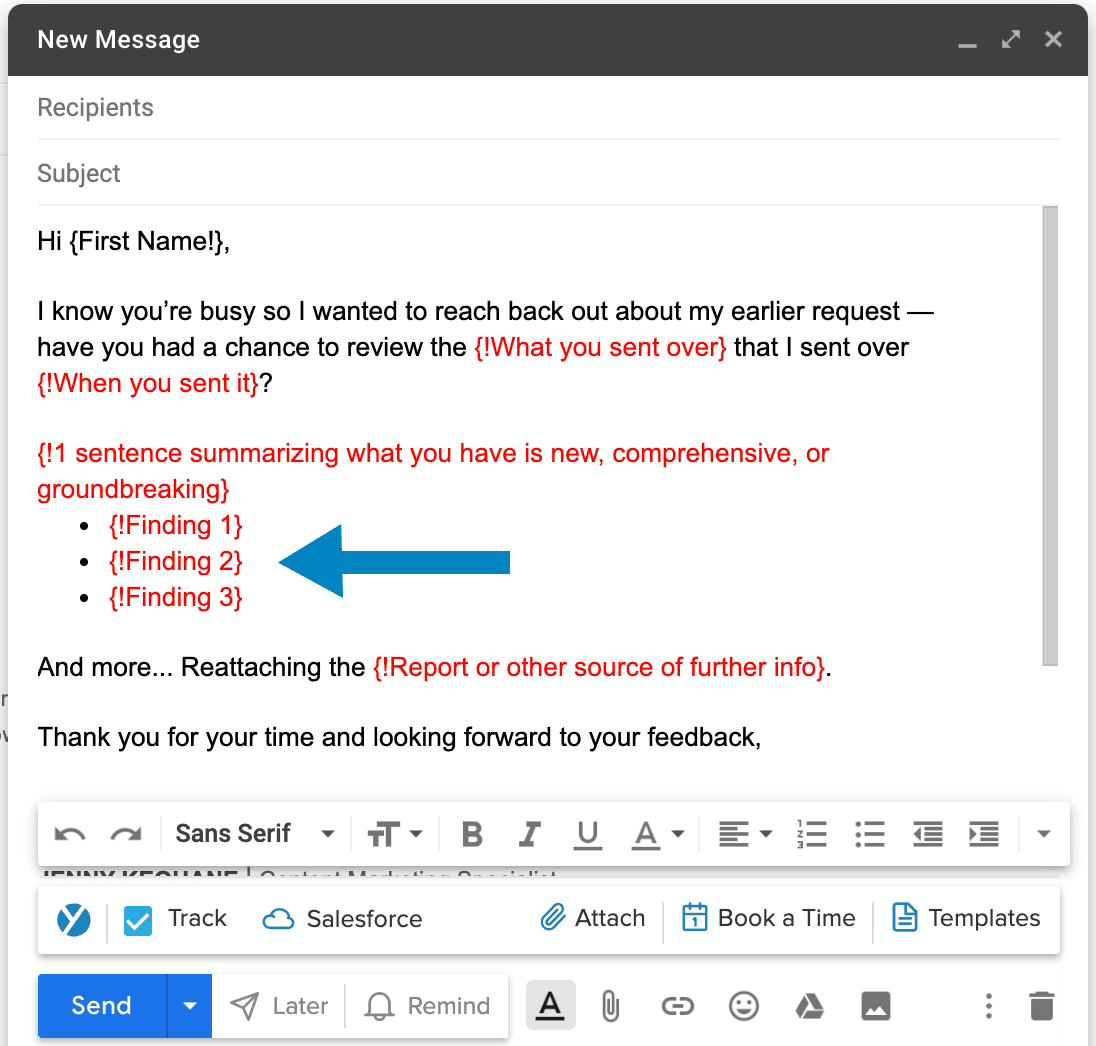
3. Communicate Through Various Channels
Salespeople today know the importance of using various channels for communication.
It’s important to have a multi-channel approach when sales prospecting. Every prospect has a different preference for communication, and it ultimately increases your visibility and likeliness of connection.
When implementing your follow-up strategy, try connecting and reaching out to prospects via social media. Studies show that salespeople who implement social selling achieve 66% greater quota attainment than those who don’t. 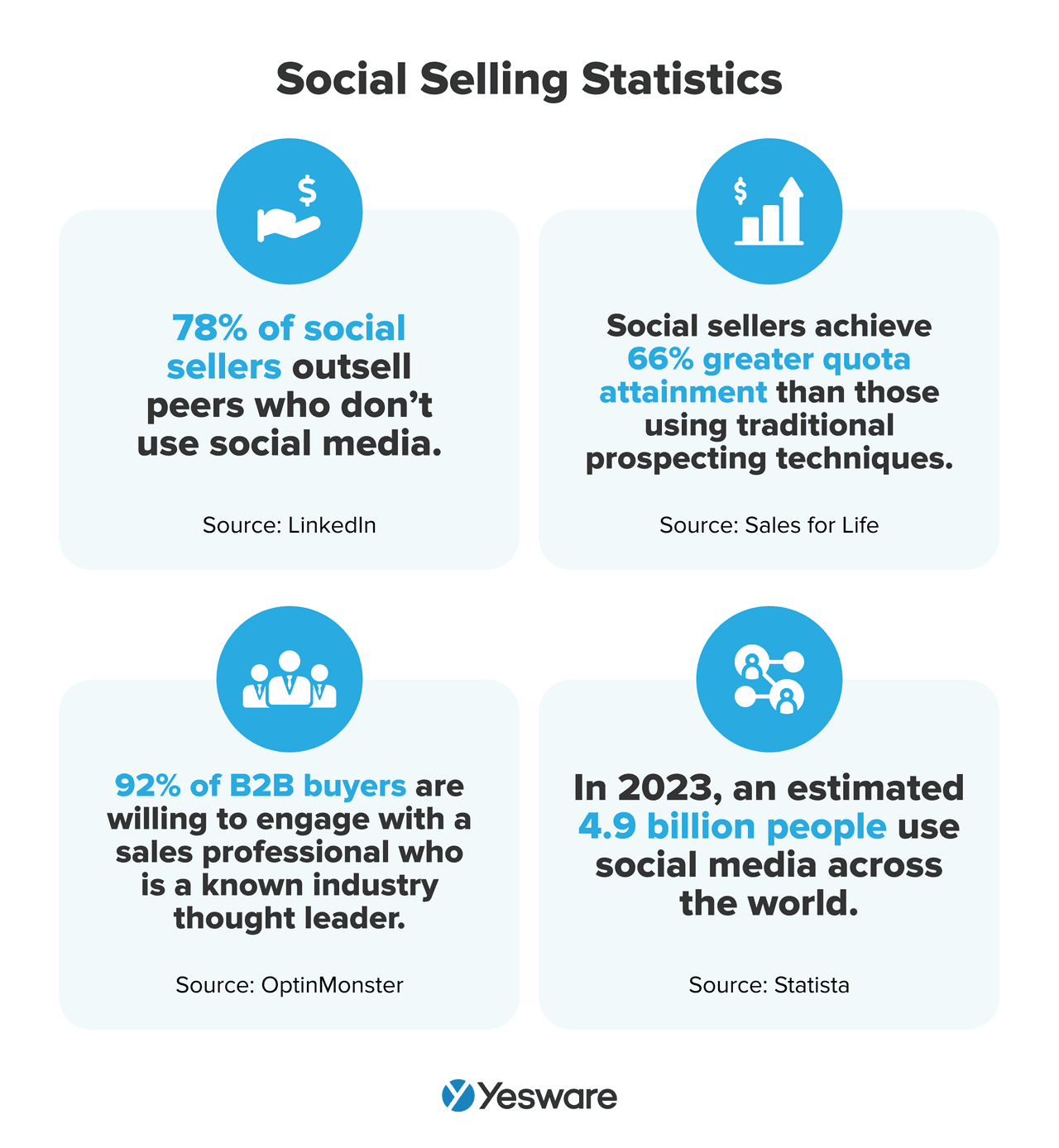 Also, it’s worth noting that cold calling is not dead. Try to implement phone calls into your cadence as well as social touches to determine the best means of communication. And after your cold call, leave a voicemail or send a follow-up email indicating that you reached out.
Also, it’s worth noting that cold calling is not dead. Try to implement phone calls into your cadence as well as social touches to determine the best means of communication. And after your cold call, leave a voicemail or send a follow-up email indicating that you reached out.
With sales tools like Yesware, you can incorporate various channels into your outreach and follow-up cadence.
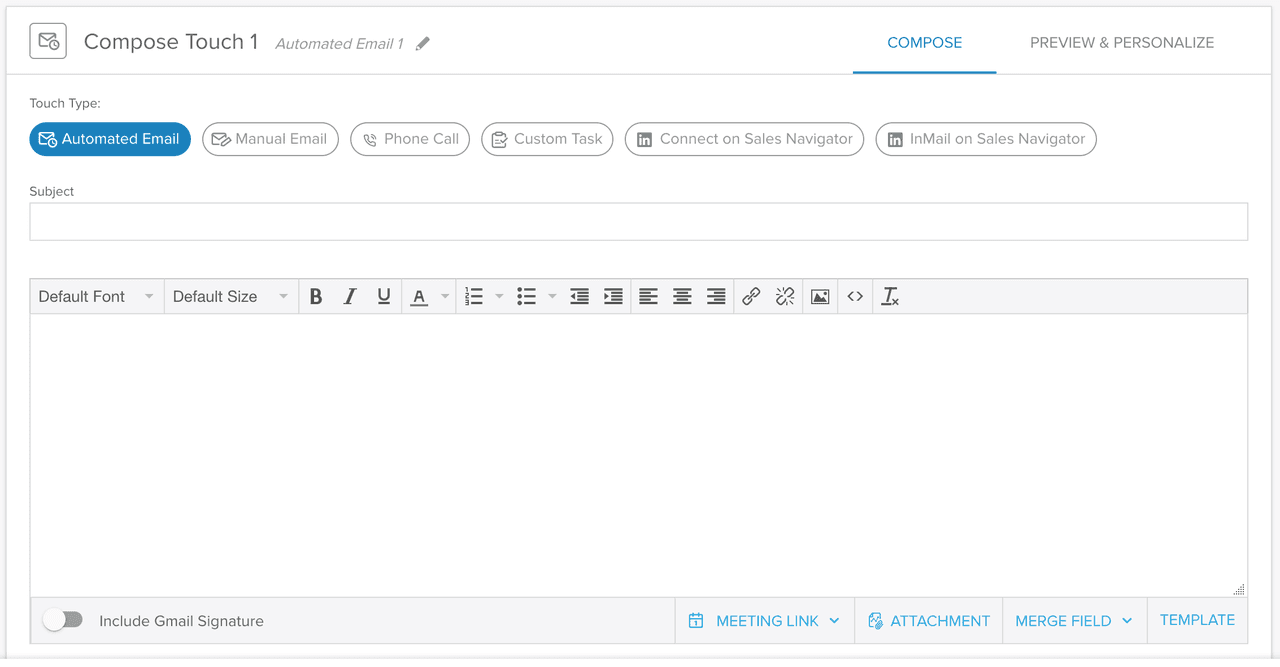
Another pro of using Yesware campaigns? You can set your follow-ups on autopilot. Pick the number of days between each touch and if the prospect doesn’t reply or book a meeting, the next touch will automatically be sent.
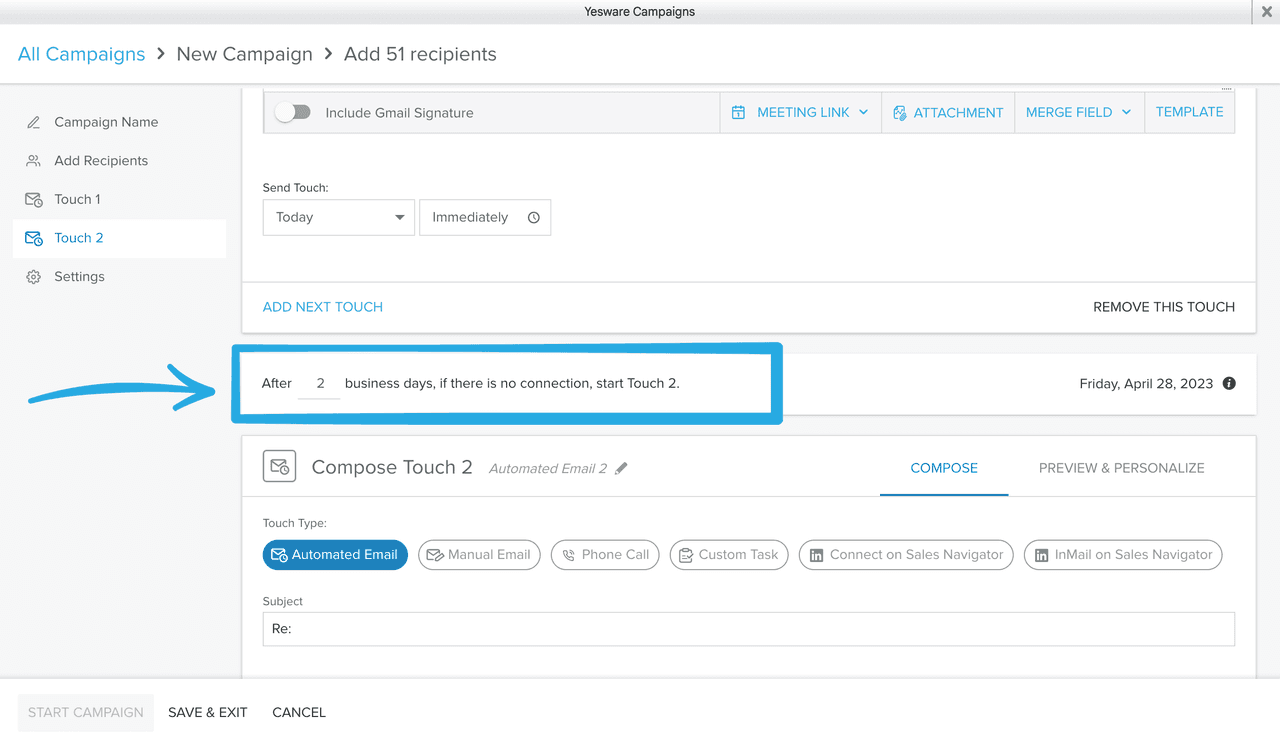
Looking to try? Get Campaigns in your Gmail or Outlook inbox for free here.
4. Personalize Your Message
When it comes to follow-up emails, throw out your one-size-fits-all tactics. With the influx of sales emails received every day in 2024, your message absolutely must be personable and relevant to get a response.
And not just personable to anyone, personable to the specific recipient you’re sending it to.
One of the best ways you can do this is by using LinkedIn to find shared backgrounds, hobbies, likes, dislikes, etc., with your recipient.
Highlighting unusual similarities could be the leg up you need to get a reply from someone who might otherwise ignore you.
Here’s an example of a personalized email that uses a connection:

Tip: Make sure your subject line is engaging and reflects the context of your message. Grab some top-performing cold email subject lines here.
5. Be Consistent
80% of sales deals take five or more follow-ups to close yet 44% of reps stop after the first attempt. That means just 8% of sales reps are consistently following up with prospects. 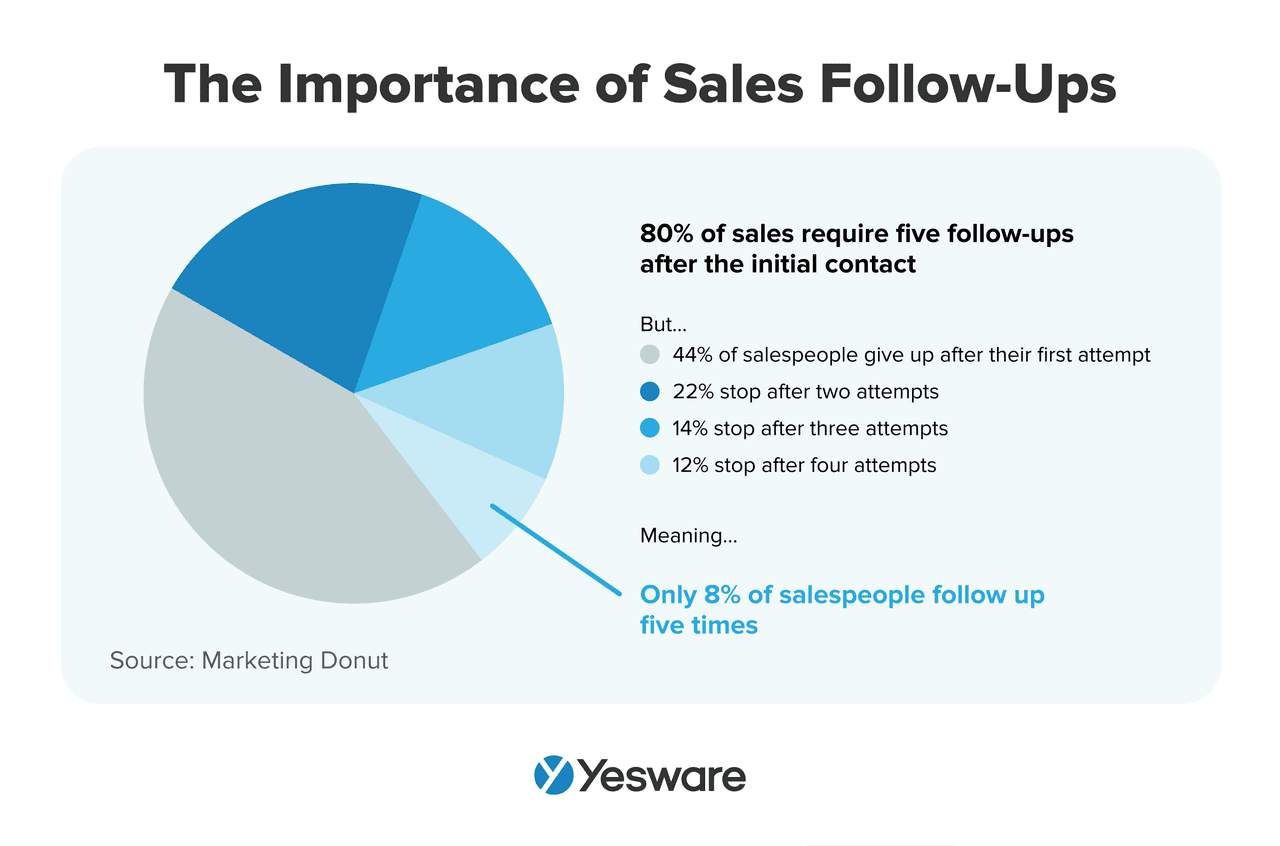 Our data, as well as various sales experts, recommend that your follow-up cadence be around six to seven follow-ups over a three-week span.
Our data, as well as various sales experts, recommend that your follow-up cadence be around six to seven follow-ups over a three-week span.
Over the three weeks, continue to send regular follow-ups until you get a response.
At the end of this time frame, if haven’t gotten a response, you can confidently conclude that now isn’t the right time for this prospect. Leave them with a final piece of value and where to contact you if the time is right in the future.
Now, let’s look at some sales follow-up statistics to back this up.
Number of Times to Follow Up & Cadence
To find the optimal number of follow-ups and time between each email, we looked at 10 million email threads sent by salespeople.
We found that the most successful cadence based on replies is six touches in the span of roughly three weeks.
The follow-up cadence chart below shows the average cadence used by reps who received replies vs. those who didn’t.
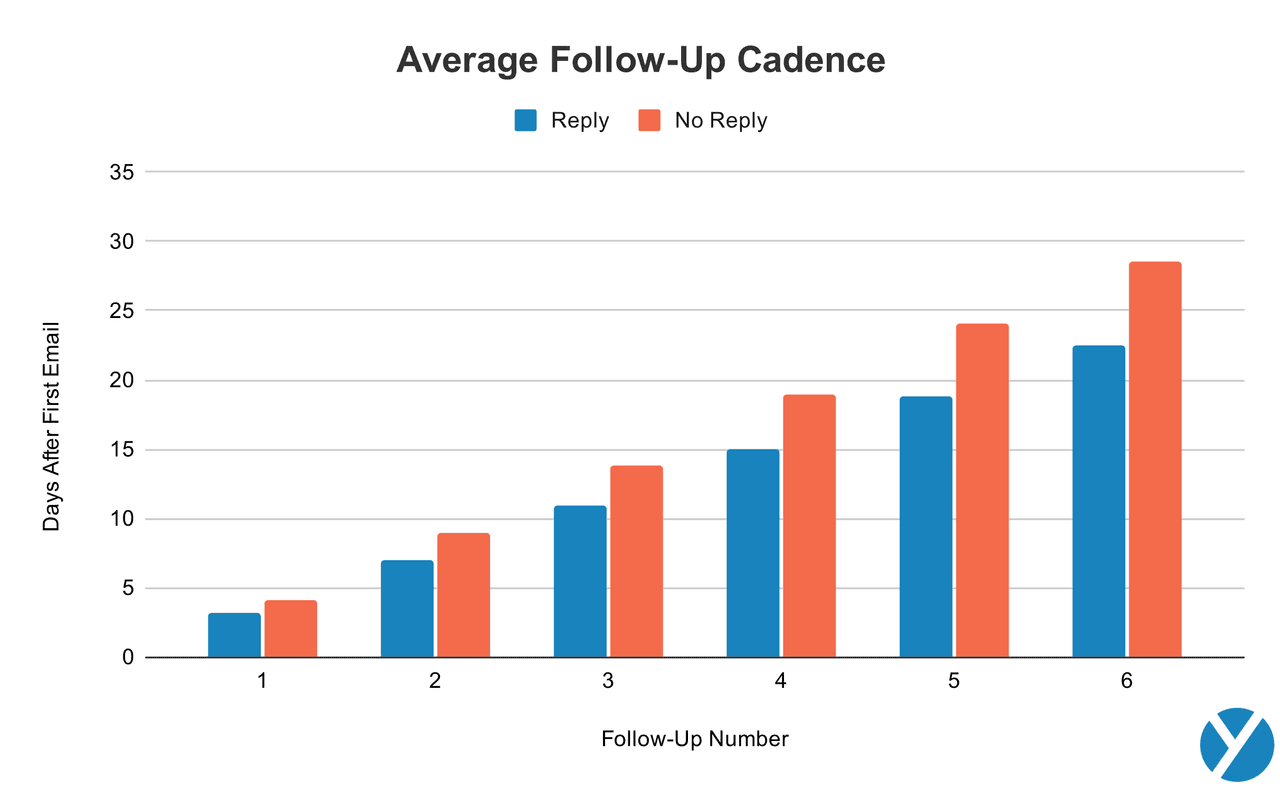 What the chart above tells you:
What the chart above tells you:
- Follow-up #1: 3 days
- Follow-up #2: 7 days
- Follow-up #3: 11 days
- Follow-up #4: 15 days
- Follow-up #5: 19 days
- Follow-up #6: 22 days
Looking at the data, it’s evident that you should spread your follow-ups out by roughly three to four days. The chart also shows that waiting more than four days typically leads to less of a chance of getting a response.
Once you implement a successful cadence, create an email campaign so that all messages will be sent on their own.
Tip: Looking for ready-to-use email templates for your follow-up cadence? Grab some of our favorites below.
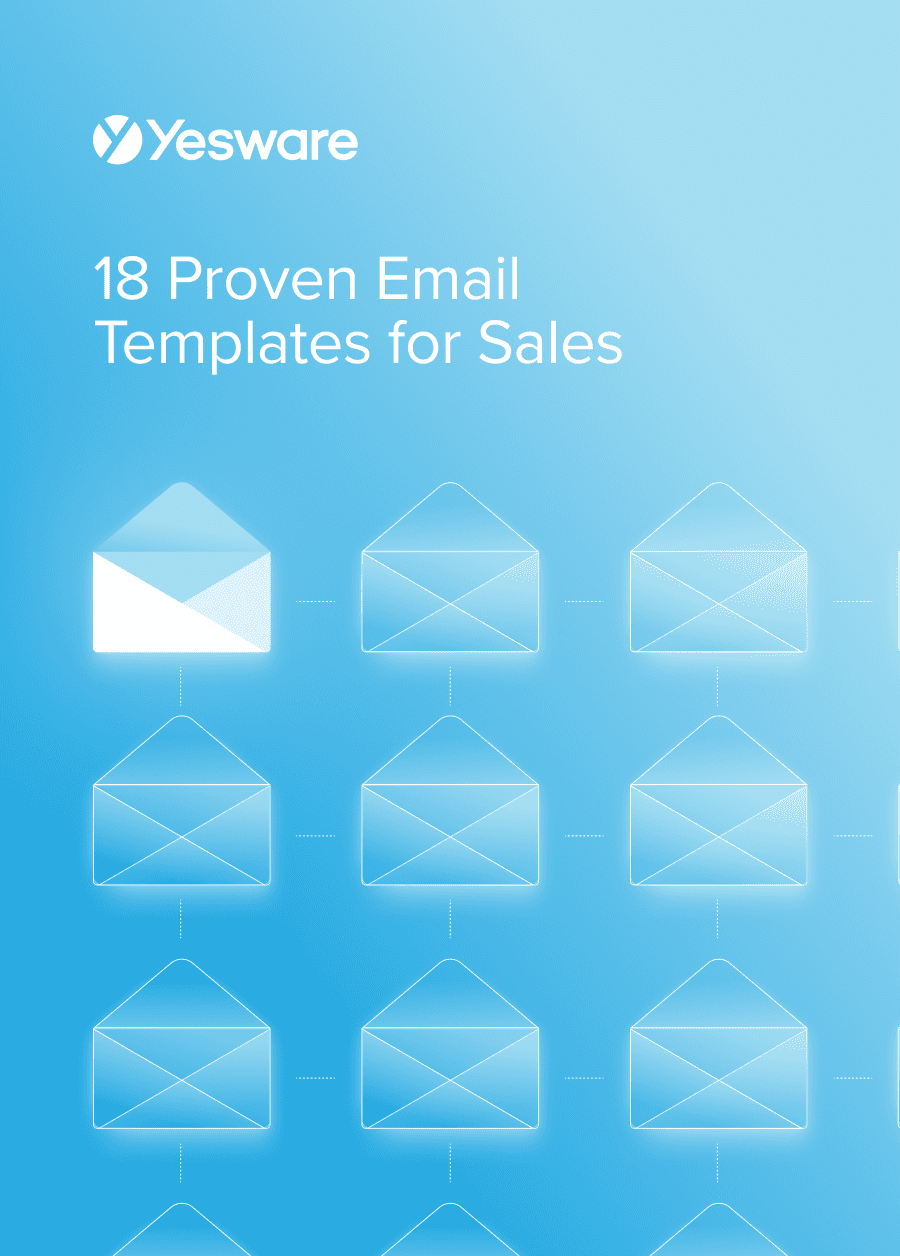 18 Proven Email Templates for SalesWinning email templates for cold outreach, follow-ups, and nurturing relationships – backed by data and real-world examples.
18 Proven Email Templates for SalesWinning email templates for cold outreach, follow-ups, and nurturing relationships – backed by data and real-world examples.
The Best Time of Day to Follow Up
Another common question when it comes to sales follow-up statistics is the best time of day to follow up.
We recommend you try different times throughout the day for each follow-up.
Why? Because if you weren’t successful with the previous follow-up email and you try again at that exact same time, you’re missing out on reaching the recipient’s inbox at their most active hour. After all, every working professional has a different schedule.
But to help lead you in the right direction, let’s break down our findings on the best time to send emails.
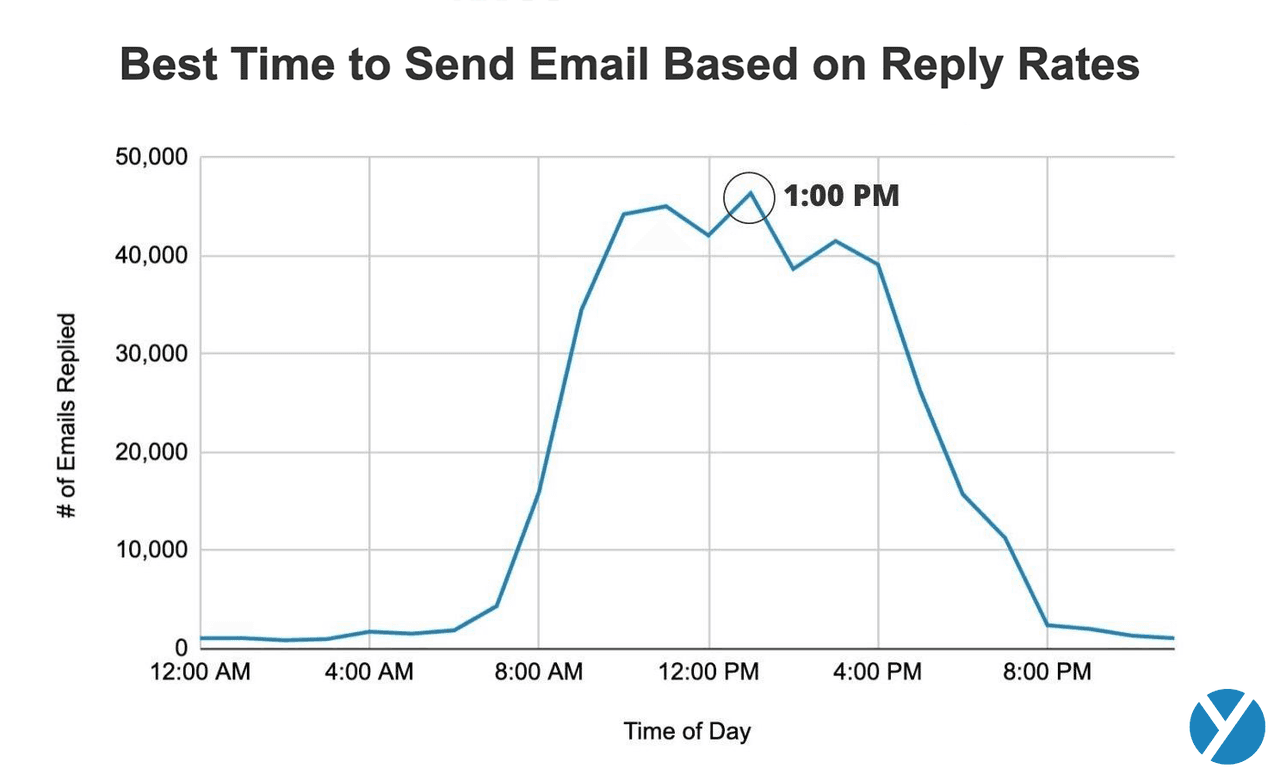 What the chart above tells you:
What the chart above tells you:
- The best time to send an email based on reply rates is 1 PM.
- The second-best time to send an email is 11 AM.
- Low reply volume exists between the time of 8 PM-7 AM.
- There’s a sudden incline in reply volume when returning from lunch (12 PM-1 PM).
So, although you should try different times for your follow-ups to see what works best for your recipients, use this data as an indication of the most active and inactive time periods.
Overall, your ideal time blocks for email outreach are 1-3 PM and 9-11 AM.
Top Sales Follow-Up Statistic: The 24 Hour Rule
To break down the significance of your first follow-up, we looked further into that specific message and found that sales reps who follow up within a day actually see a higher reply rate.
Our data shows that sales reps who follow up within a day of their initial outreach receive about a 25% reply rate on average.
To clarify, we don’t necessarily recommend sending subsequent emails day after day, but for your first follow-up email, sending this message within 24 hours can significantly increase your chances of getting a reply.
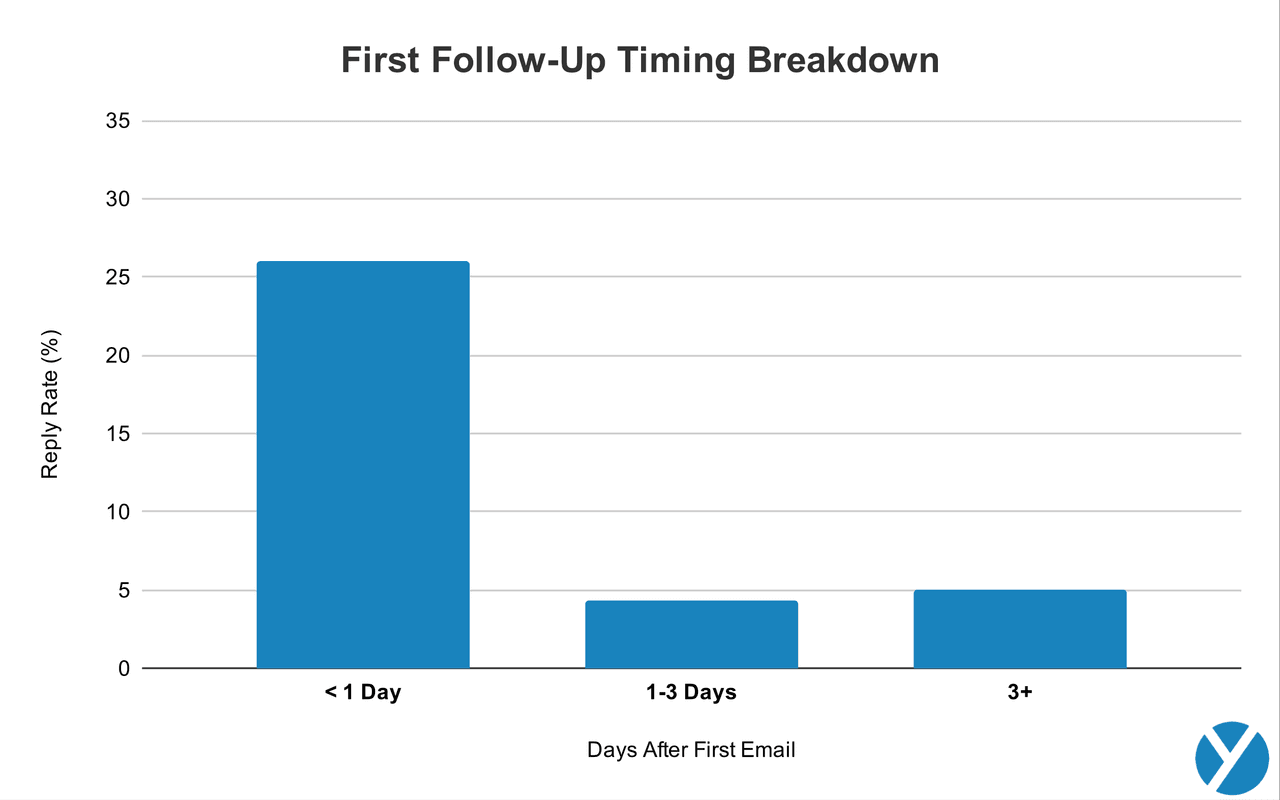
The Most Effective Sales Follow-Up Templates
Now, let’s look at some top-performing sales follow-up templates to help you implement your strategy with the above statistics.
1. The Reference Follow-Up Template
Hi {!FirstName},
I just spoke with {!Person} over the phone who pointed me in your direction.
I reached out to {!Person} because I noticed that your {!Department} team is {!Pained situation}, which we hear is a major challenge {!Why/how it’s challenging}.
{!My Company} would automatically {!Paint the solution}. {!Person} suggested we have a conversation.
Could you and I arrange 15 minutes this week to explore how {!Your Company} could leverage {!My Company}?
Thanks for your time,
{Your Name}
2. Redemonstrate the Value/ Second Pitch
Hi {First Name!},
I know you’re busy so I wanted to reach back out about my earlier request — have you had a chance to review the {!What you sent over} that I sent over {!When you sent it}?
{!1 sentence summarizing what you have is new, comprehensive, or groundbreaking}
{!Finding 1}
{!Finding 2}
{!Finding 3}
And more… Reattaching the {!Report or other source of further info}.
Thank you for your time and looking forward to your feedback,
{Your Name}
3. Follow-Up Email Template for Inbound Lead
Hi {!First Name},
I noticed you got a chance to take a look at some of our content, specifically the piece {!Title of content}. I hope you found some value there!
{!Question triggering pain point}? It’s a reality in {!Their field} today, and the reason why {!How your company aligns}. I would love to {!action you’re looking for} {!what it accomplishes for them}. {!Statement that shows your differentiation}.
{!First name}, do you have {!amount of time} free on {!Day} {!time of day}?
Looking forward to your reply,
{Your Name}
4. Case Study Follow-Up Email
Hi {!First Name},
I know we’re still in a holding pattern, but I wanted to send over a customer case study that speaks to how {!Customer Name} leveraged {!type of product/service you offer} to {!What they accomplished — HARD METRIC}.
What sort of timelines do you think we’re looking at to pick this back up?
Thanks!
{Your Name}
5. Follow-Up Email After No Response
Hi {!First Name},
In case you missed my email {!week/day you sent it}, {!restate why you’re reaching out}. {!Value statement specific to recipient}.
My ask for you:
- {!First part of ask}
- {!Second part of ask}
{!Any additional information}.
Looking forward to your reply,
{Your Name}
6. The “Break Up” Follow-Up Email
Hi {!First Name},
I’ve been reaching out because I see a great opportunity for your team to {!Outcome 1}, {!Outcome 2}, and {!Outcome 3}.
Hate to be a bother, so I’ll plan on reconnecting in a few months, unless you tell me you’re ready to evaluate sooner. If you were interested in getting your team on a pilot period to try us out, I could help set that up too.
In the meantime, I’ll definitely keep an eye out for {!Your company} news!
Thanks for your time,
{Your Name}
Tip: Add these templates to your inbox using Yesware so you can track their success rates.

Conclusion
In sales, it certainly pays to be proactive.
Ultimately, with every follow-up email you send, you increase your chances of getting a reply.
Take these sales follow-up statistics and build out/edit your cadence to see if it drives results.
Continue to reflect on your sequence and what elements need improvement. And always track the performance of your emails so you’re on top of your response rates, open rates, conversion rates, and ultimately, what messaging is resonating with recipients and what’s not.
This guide was updated on February 26, 2024.
Get sales tips and strategies delivered straight to your inbox.
Yesware will help you generate more sales right from your inbox. Try our Outlook add-on or Gmail Chrome extension for free, forever!
Related Articles
Anya Vitko
Yesware
Jenny Keohane
Sales, deal management, and communication tips for your inbox
![Top Sales Follow-Up Statistics for 2024 [+ Templates]](/blog/_next/image/?url=https%3A%2F%2Fwww.yesware.com%2Fwp-content%2Fuploads%2F2021%2F04%2Fyesware-sales-follow-up-statistics.jpg&w=1984&q=75)
